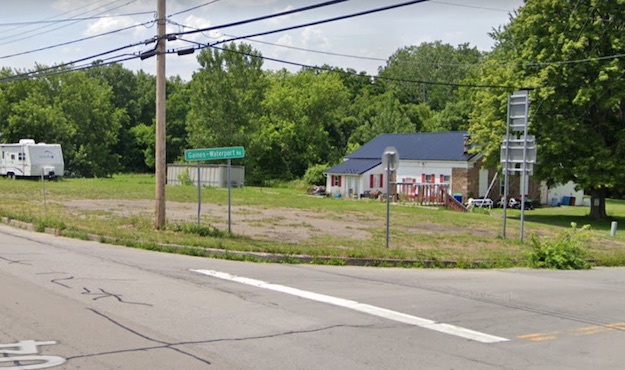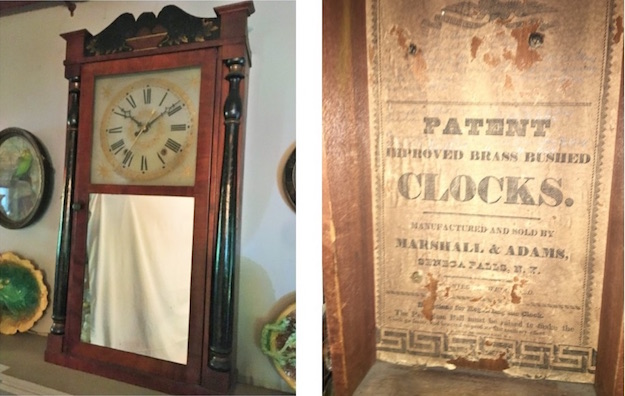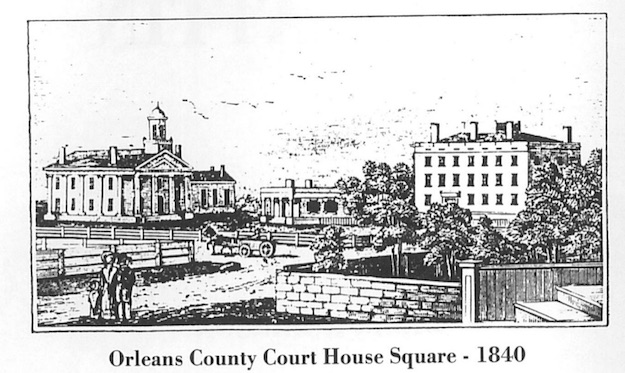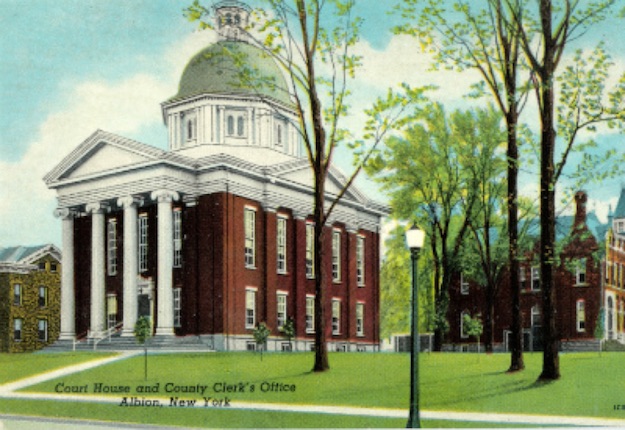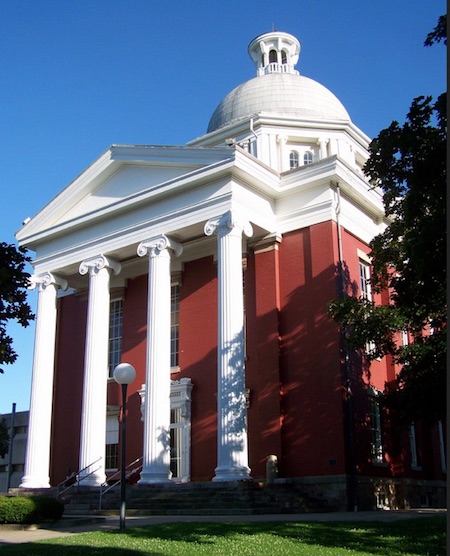Historic Childs: Orleans County Court originally was on the Ridge in Gaines
Albion beat out Gaines for County Seat in 19th century controversy
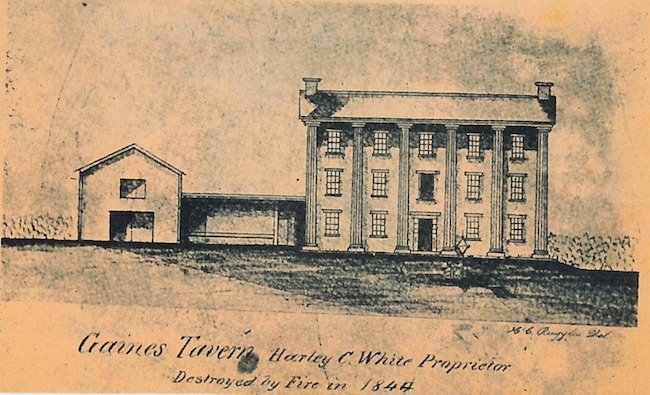
Mansion House, circa 1840, Delineation by H. C. Ruggles
By Doug Farley, Director – Vol. 2 No. 34
GAINES – Orleans County is fortunate indeed to have a beautiful courthouse as a focal point to an impressive, historic, Courthouse Square. However, the location of the current courthouse didn’t get selected without considerable 19th century controversy. In fact, at one point in early history, Gaines was the primary contender for the County Seat.
The sketch at the top shows the first County Court, which was held in the home of Selah Brown, alternatively known as the Mansion House. The stately historic stagecoach stop was a building that former Historian, Cary Lattin, once described as “one of the most imposing buildings on the Ridge Road in the 19th century.”
The Mansion House was described as a large, three-story wooden structure with high Grecian columns as seen in the above sketch. From the record books we know that the first Court of Common Pleas in the county was held in the Mansion House on June 22, 1825.
Built in 1816 by William Perry, the Mansion House was located on the northwest corner of what we know today as Ridge Road and Route 279 in Gaines, shown above. Also called the Gaines Tavern, the Mansion House can be placed in your minds-eye in the vacant lot just south of the still extant former cobblestone schoolhouse on that corner, now occupied by a motorcycle club.

(Left) Portrait of Gen. Winfield Scott painted by Robert Walter Weir in 1855. (Right) Portrait of Senator Henry Clay painted by Henry Darby, 1858.
The history of the Mansion House was unfortunately short lived. It was completely destroyed by fire in 1844. During its short tenure, however, it laid claim to such distinguished guests as General Winfield Scott (above left) and Henry Clay (above right), who entertained local gentry during stops along the Ridge.
The only known memento of the tavern that still exists is a clock that stood on the bar in 1836 before the fire. Former Historian Cary Lattin purchased the clock at Knickerbocker’s Auction in the 1920s. It was said the clock was rescued from the fire at the Mansion House. It had a wooden clock works which Lattin later replaced with an electric works in the 1950s. The clock’s manufacturer was Marshall & Adams of Seneca Falls. A handwritten note insides the clock dates it to c.1833.
History records that at least one momentous decision was made at the court session that took place at the Mansion House that still affects life today. The decision was made at the Mansion House to locate the Orleans County Seat in Albion, thus ending the building’s short reign as the County Courthouse.
The political maneuverings that went into the decision in question is also an interesting story. In 1826, Commissioners were appointed to determine whether Gaines, the more thriving community, or Albion, the approximate geographical center of Orleans County, should be chosen as the County Seat. The machinations of the local citizenry involved in the decision was described in detail in “Pioneer History of Orleans County,” 1871, as follows:
When the Commissioners appointed to select the site for the Court House came on to fix the spot, their choice lay between Gaines and Albion. Gaines had the advantage of being the largest village, being on Ridge Road, and being well supplied with mechanics and merchants, and of having many of the institutions of old and well organized communities established there. Albion was nearest the geographical center of the county, and was intersected by the Erie Canal and Oak Orchard Road. The west branch of Sandy Creek runs through the east part of the village. Rising in some swamps in the southern part of the town, it afforded sufficient water after the melting of the snow in spring, and after rains to turn machinery a part of the year, but in summer was nearly dry. On this stream two saw mills had been built, one in the village, the other south of it.
The Commissioners came to consider the claims of the rival villages about the middle of the dry season. Mr. Nehemiah Ingersoll, Philetus Bumpus, Henry Henderson, and a few other Albion men, determined to use a little strategy to help Albion. Knowing when the Commissioners would be here the creek would be too low to move the sawmills, and foreseeing the advantage a good mill stream would give them, they patched the two dams and flumes and closed the gates to hold all the water some days before the Commissioners would arrive; sent some teams to haul logs and lumber about the saw mill and mill yard, in the village to mark the ground and give the appearance of business there.
When the Commissioners came to see Albion, having been generously dined and wined by its hospitable people, they were taken in a carriage to see the place, and in the course of the ride driven along the creek and by the sawmill, then in full operation, with men and teams at work among the lumber, with a good supply of water from the ponds thus made for the occasion. The commissioners were impressed with the importance of this fine waterpower and gave the county buildings to Albion before the ponds ran out.
Incredibly, all the buildings illustrated in this 1840 wood cut engraving have been demolished. From left to right we see the original County Court House built in 1827 and removed in the late 1850s. Seen next is an early County Jail erected in 1838 and torn down in 1902. In the center is shown the first County Clerk’s Office built in 1836 and razed in 1884. The large building to the far right was Phipps Union Seminary demolished in 1882. The steps in the lower right corner were those of the original First Baptist Meeting House, 1832-c1892. The retaining wall pictured (still extant) was located at the Roswell Burrows residence which became the Swan Library building.
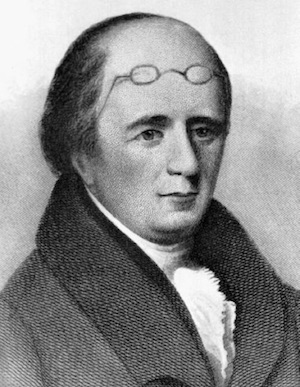
William Morgan (1774-c1826), Unknown artist
The first Court House erected in Albion was built in 1827 in front of the current Courthouse, on land donated by Nehemiah Ingersoll. The initial court session was held there on March 26, 1827. The courthouse was built with bricks and originally faced west, towards the main street.
It also housed the County Clerk’s Office on the first floor. Cells for housing county prisoners were built in the basement and were used until a new jail was built in 1838. In 1828, somewhat belatedly, the Legislature officially transferred the court from Gaines to Albion.
The first court case conducted in the court in Albion was “People of the State of New York vs. Avery Downer.” The murder case had a great public interest at the time, and still remains an enigma, today. Elihu Mather and Avery Downer were accused of conspiracy to kidnap and abduct William Morgan (shown at right) who had allegedly been spirited into Canada and killed because he was writing an expose of the secrets of Free Masonry. Downer, a schoolmaster, never did stand trial, but Mather did, and was finally acquitted after a ten-day trial. Morgan’s body was never found and to this day the mystery of his disappearance remains unsolved.
With the passing of time, the first Courthouse became too small for the needs of a growing county. Accordingly, in 1856, the Board of Supervisors of Orleans County adopted a resolution to consider the question of building a new Court House. A public hearing was held and as a result, the Board of Supervisors appropriated $20,000 for the building of a new Courthouse. The architect for the project was W. V. N. Barlow.
The new Courthouse was completed in November 1858 and was built facing north on Courthouse Square. The Board of Supervisors noted this accomplishment with these remarks in 1858:
A Court house has been built…which for beauty of design, strength of structure, and completeness of finish, is not excelled if equaled by any similar building of equal cost, in the State. We feel impelled to render this testimony to the thorough and economical manner in which said Commissioners have prosecuted their labors in the erection of said Court House.
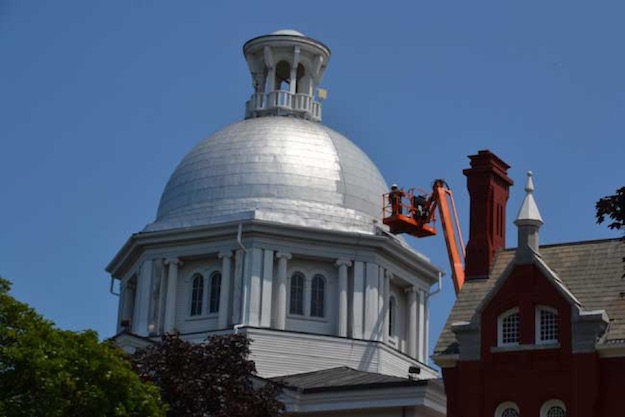
Courthouse dome undergoing maintenance, 2019
The dome on the top of the Courthouse comprises the last 36 feet of the building’s overall height of 100 feet. A trapdoor is found at the top of the dome leading to a platform from which one can see Lake Ontario some 12 miles away.
A quartet of musicians was known to play from this height during the Christmas season. For many years, the Courthouse bell in the tower was rung to mark the opening of court sessions. It was also rung on November 11, 1918 to mark Armistice Day for World War I, and again on January 19, 1959 to celebrate the 100th birthday of the building.
The Courthouse today stands in a beautifully kept square, together with the County Clerk’s building and County Jail. At least one church still stands on each corner as a reminder of the importance of faith to the county’s citizens. In 1959, local attorney, Curtis L. Lyman offered some appropriate words we can use today to close this historical review:
The people of Orleans County are proud of their Courthouse. They have put it to good use and have taken good care of it. They know that as a result of their continuing care and maintenance the Courthouse will provide many years of useful service. They also know that by preserving this handsome reminder of the county’s past, they are building a strong future for themselves, based on a sense of history, of respect for established institutions, and of faith in the stabilizing influence of even-handed justice in American life.
These words were first given during a ceremony marking the Centennial celebration of the Court House in 1959 when the importance of the building and the institution were acknowledged by the NYS Bar Association.
























